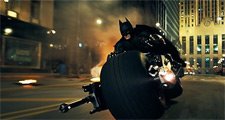 I think we can generally agree that Christopher Nolan and Heath Ledger have created a goddamn masterpiece, and even though Christian Bale and Maggie Gyllenhaal didn’t really provide the magic that made it happen, they certainly pulled their weight. Everybody’s been talking about The Dark Knight, and there’s a reason for that… it’s an unmatched piece of cinema work, not just a great comic book film, but a great film in general. Disguised under the action, this is a film driven by the psychological confrontations, and it takes on the power of an epic suspense thriller, a la The Game or Primal Fear. It matches, and even surpasses these movies, because the villain is so powerful and terrifying, and because it develops its psychological relationships throughout a whole host of characters, rather than simply between two or three. I hope it’s the first comic book / action movie to win a really important Academy Award.
I think we can generally agree that Christopher Nolan and Heath Ledger have created a goddamn masterpiece, and even though Christian Bale and Maggie Gyllenhaal didn’t really provide the magic that made it happen, they certainly pulled their weight. Everybody’s been talking about The Dark Knight, and there’s a reason for that… it’s an unmatched piece of cinema work, not just a great comic book film, but a great film in general. Disguised under the action, this is a film driven by the psychological confrontations, and it takes on the power of an epic suspense thriller, a la The Game or Primal Fear. It matches, and even surpasses these movies, because the villain is so powerful and terrifying, and because it develops its psychological relationships throughout a whole host of characters, rather than simply between two or three. I hope it’s the first comic book / action movie to win a really important Academy Award. There’s going to be a lot of talk about it, though, so I’m going to try to look at it through a specific lens. Rather than replicate the many orgasming movie critics and drooling bloggers, I’m going to try to analyze Nolan’s fine piece of work by way of an implicit “Other,” an almost Godlike character who appears in every scene, but who isn’t acted by anyone famous, and who doesn’t even appear in the credits. This character is
Note: there may be spoilers in the next couple blog posts. There aren't really any in this one, though.
A DARK KNIGHT IN
Fictional cities as the central figures in comic book films: however rare and quirky this sounds, it’s actually something that’s already come up, and something that’s going to be coming back up again soon. Give me a moment on a tangent, please… I’d like to talk about Frank Miller.
Frank Miller actually wrote the comic book The Dark Knight Returns, which is the landmark use of that nickname. His comic, published in 1986, was Batman’s ticket out of the blue suit and bad effects of the old Batman comics and television show. It was about Bruce Wayne returning from retirement to fight crime as an old man, and the psychological and ethical demons he had to face in a new era of crime and cruelty. Miller’s series established the gritty, violent image that Nolan is now working with. Within Nolan’s plot, the copycat Batmen may even be an homage to the imitators in Miller’s Dark Knight Returns. However, aside from this homage and the similarity in tone, the plot of Miller’s 1986 comic has nothing to do with Nolan’s film.
Miller created another comic title, independent of the DC mythology, entitled
I fear the same problem from Miller’s upcoming film, The Spirit. Again, The Spirit is about the character of a city… the tagline for the movie is, “My city screams. She is my lover. I am her spirit.” The trailers and promotional material give the sense of a city that’s defined by an anonymous hero and a twisted maze of sexual tension. Unfortunately, they also give the sense of a city that’s created in Adobe Illustrator, rather than discovered on the urban streets.
Nolan’s

No comments:
Post a Comment